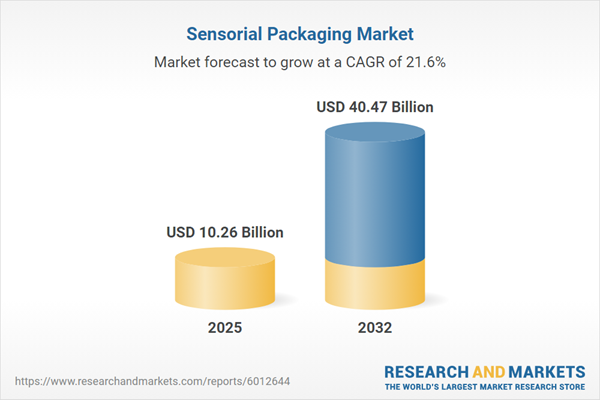Speak directly to the analyst to clarify any post sales queries you may have.
Sensorial packaging is redefining brand strategies by turning packaging into an active brand touchpoint, where multi-sensory elements enhance consumer engagement, product value, and longevity of brand relationships. As the market for sensorial packaging expands, understanding the key dynamics behind its growth is vital for senior decision-makers in competitive consumer sectors.
Market Snapshot: Sensorial Packaging Market Performance
The Sensorial Packaging Market grew from USD 8.46 billion in 2024 to USD 10.26 billion in 2025. It is expected to maintain robust momentum with a CAGR of 21.60%, reaching USD 40.47 billion by 2032. This trajectory signals heightened investment and adoption across global industries, propelled by innovations in materials science, printed electronics, and the drive for brand differentiation. Demand accelerates as manufacturers seek to engage multisensory consumer preferences and integrate interactivity into packaging, especially in segments such as cosmetics, personal care, FMCG, food and beverage, and healthcare.
Scope & Segmentation of the Sensorial Packaging Market
- Application Areas: Cosmetics and personal care products (hair care, make-up, skin care), fast-moving consumer goods such as homecare and personal hygiene, food and beverage (beverages, dairy products, packaged foods), and healthcare products including medical devices and pharmaceuticals.
- Technology Types: NFC and RFID tags (active and passive), printed electronics (OLED, sensors), QR codes, and smart labels with embedded electronic capabilities.
- Material Categories: Glass (bottles, jars), metals (aluminum, steel), paperboard (corrugated, folding cartons), and plastics (HDPE, LDPE, PET, PVC).
- Sensor Features: Auditory cues, gustatory enhancements, olfactory features, tactile textures, and dynamic visual components.
- Packaging Forms: Bottles and cans, cartons and boxes, pouches and sachets, seals and films.
- Regional Coverage: Americas (United States, Canada, Mexico, Brazil, Argentina, Chile, Colombia, Peru), Europe, Middle East, Africa (with markets such as Germany, United Kingdom, France, UAE, Saudi Arabia, South Africa), and Asia-Pacific (China, India, Japan, Australia, South Korea, Indonesia, Thailand, Malaysia, Singapore, Taiwan).
Key Takeaways for Strategic Decision-Makers
- Sensorial packaging enhances brand engagement by leveraging tactile, auditory, olfactory, and visual cues, encouraging deeper consumer connections.
- Rising demand for personalization and interactivity is fueling adoption of advanced technologies such as NFC and printed sensors, especially in premium product categories.
- Regulatory requirements and evolving sustainability standards are prompting brands to adopt recyclable substrates and optimize sensor integration for eco-friendly outcomes.
- Strategic partnerships between packaging converters, technology suppliers, and material scientists are creating scalable solutions that balance experience and environmental compliance.
- Segment-specific strategies, such as the use of kinetic packaging in cosmetics or smart labels in food and beverage, allow brands to meet unique consumer and regulatory needs in each vertical.
- Regional innovation ecosystems, ranging from North American focus on digital engagement to Asia-Pacific's leadership in micro-sensor technology, shape local market entry strategies.
Tariff Impact: United States Trade Policy Considerations
Forthcoming United States tariffs slated for 2025 are anticipated to reshape raw material and technology cost structures for sensorial packaging. Higher import duties on key materials such as glass, aluminum, steel, and specialty plastics, alongside sensor modules and NFC components, may influence sourcing choices and require adjustment of supply chains. To maintain market competitiveness, proactive responses include vendor diversification, vertical integration, and pilot programs testing modular sensor attachment techniques.
Methodology & Data Sources
This report utilizes a rigorous multi-method research approach, combining in-depth executive interviews, end-user focus groups, and analysis of regulatory filings and industry publications. Quantitative validation encompasses case studies, pilot program reviews, and technical evaluations in partnership with materials and electronics integration laboratories. Findings are peer-reviewed by independent consultants and refined using structured segmentation frameworks.
Why This Report Matters
- Enables senior leaders to benchmark sensorial packaging investments and strategies against peer organizations and evolving industry best practices.
- Supports informed portfolio optimization by clarifying technology, material, and application segment relevance across regional growth profiles.
- Provides actionable guidance on navigating regulatory, sustainability, and supply chain shifts central to future-proofing packaging strategy.
Conclusion
Sensorial packaging is evolving into a strategic lever for brand competitiveness as digital interactivity, sustainability, and consumer demands converge. Timely insights on segmentation, regional factors, and technology adoption are crucial for maximizing value creation and long-term growth in this dynamic landscape.
Additional Product Information:
- Purchase of this report includes 1 year online access with quarterly updates.
- This report can be updated on request. Please contact our Customer Experience team using the Ask a Question widget on our website.
Table of Contents
3. Executive Summary
4. Market Overview
7. Cumulative Impact of Artificial Intelligence 2025
Companies Mentioned
The companies profiled in this Sensorial Packaging market report include:- Amcor PLC
- Law Print & Packaging Management Ltd.
- Sealed Air Corporation
- Smurfit Kappa Group plc
- WestRock Company
- SWM International
- Pro Carton
- Mérieux NutriSciences Corporation
- D.C.M. Srl
- Smartech Global Solutions Ltd.
Table Information
| Report Attribute | Details |
|---|---|
| No. of Pages | 194 |
| Published | November 2025 |
| Forecast Period | 2025 - 2032 |
| Estimated Market Value ( USD | $ 10.26 Billion |
| Forecasted Market Value ( USD | $ 40.47 Billion |
| Compound Annual Growth Rate | 21.6% |
| Regions Covered | Global |
| No. of Companies Mentioned | 11 |









